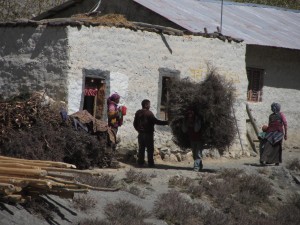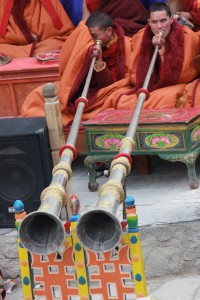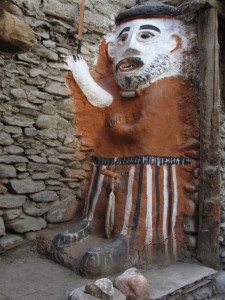
We are strong, fast, and feeling good. We covered ten miles in four hours, beating the pack mules and handlers to camp for the first time. Hiking at 2 1/2mph at 13,000′ is moving fast.
We trekked over the highest pass of the trip today at 13,800′, and earned a full afternoon of free time after a wonderful, leisurely lunch. Much of the lower altitude landscape (between 10,000′ and 15,000′) looks like a combination of the Badlands, Bryce Canyon and Sedona. Ranges of snow capped peaks popped in and out of view in surprise appearance.
We camped on the grounds of an eighth century monastery, the oldest in Upper Mustang, and ate in the monks’ common room. This is the perfect place for us today: quiet, sacred, and old.

As with all of Upper Mustang, there are few resources and lots of harsh realities. The buildings are made from stone and mud and timbers from lower elevations. Little grows well in the parched, rock and sand soil. It’s the end of May and only now the first leaves are appearing on the trees. There are five, large, untouched, centuries-old trees here that haven’t been turned into a firewood producing trees. We’ve seen nine of these still-natural ancient trees, five here at this monastery and four we camped under in the capital, just yesterday. We’re told there are no others in Mustang.

The caretaker let us in to see the monastery before dinner. There are only two small rooms, both with 1,200 year old stone carvings and paintings. They emanate the deepest flavor of ancient sacredness we’ve found in Mustang. Afterwards, we walked the perimeter of the main monastery building, each of us spinning all of the 108 old prayer wheels tucked into the walls. The deep orange of the buildings became richer as the sun neared the horizon.
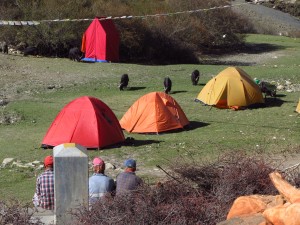
There is almost always some background chatter, mostly in Nepalese. The first couple days it annoyed me. I came here looking for silence, among other things, and I found people.
People are noisy. They talk, clomp around, make cooking noises, eating noises, and they shout from house to house and sometimes neighborhood to neighborhood. They whistle, sing, and shout at their animals. Now that noise is simply the background hum of everyday life.

This monastery is the first completely quiet place of the trek. No people other than our group of eleven. We four are camping in a grazing meadow, far from the others who are sleeping on padded benches in the common room. No monks. I wonder where they are. All I hear during the night are sheep and goat bells, the distant river’s roar far below, and an occasional zipper sound as someone crawls out of their tent to relieve themselves.
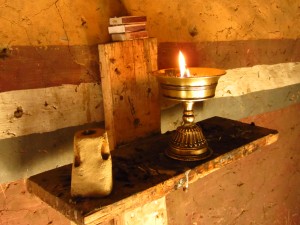
Mid-afternoon, a goat herder greeted me and asked for help. From the looks of it, he gashed the palm of his hand a few days ago. It was black with dust and scabs. With no language in common and no interpreter in sight, I knew I couldn’t teach him about keeping cuts clean and bandaged, but I could at least take him to my tent and smother the wound with Neosporin, and put bandages to keep the cream in place. It was a small, but tender interaction, filled with human warmth and connection. I don’t know if I really helped, but the need that prompted our meeting was a powerful reminder of the harshness of life here.
As beautiful as Mustang is, it’s not fantasy land. Perhaps the greatest attraction of Mustang for me is its purity.
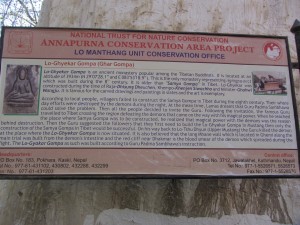
Everything is quite real. Stones and mud, sheep, mules, yak, horses and chickens make life possible. The essentials are barley, butter (cow, yak, or sheep) for the Tibetan tea, and dried meat for food, and dried dung, very limited firewood, and bottled gas (brought in on mule back from the nearest city, three days distant), for cooking. The beliefs of Tibetan Buddhism are at the core of life, and the monasteries educate the boys.
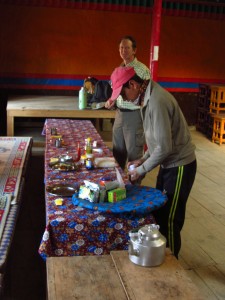
The streets are all swept early morning and animals roam freely. Clothes are washed at the communal well amid gossip and laughter. Women take watch of the kids, weave, cook, and take care of the house. Men till the fields, help take care of livestock, build houses and drink moonshine when available. Life goes on…

